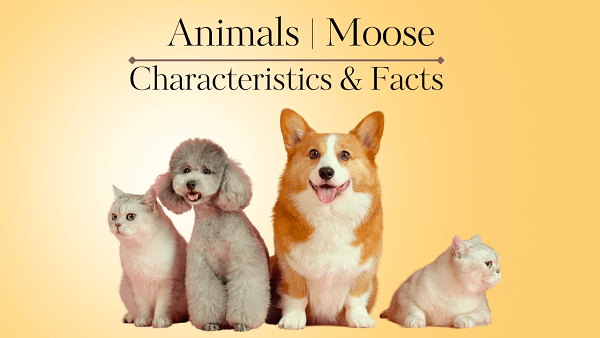Moose Definition | Characteristics & Facts
Home » Animals » Moose Definition | Characteristics & Facts
Moose Definition: A moose is a large, solitary, and herbivorous mammal belonging to the deer family (Cervidae) and the species Alces alces. They are native to northern regions of North America, Europe, and Asia, inhabiting forests and wetlands.
Moose General Characteristics & Facts
General Characteristics of Moose with definition:
Size
Moose are one of the largest land mammals in North America and Eurasia. Adult males, known as bulls, can stand up to 6.5 feet (2 meters) at the shoulder and weigh between 800 to 1,500 pounds (360 to 680 kilograms). Females, known as cows, are slightly smaller.
Antlers
Male moose have large, broad, and palmate antlers that can span up to 6 feet (1.8 meters) across.
Diet
Moose are herbivores and primarily feed on vegetation such as leaves, twigs, buds, and aquatic plants. They are especially fond of aquatic plants like water lilies.
Behavior
Moose are mostly solitary animals, except during the mating season and when cows are raising their calves. They are known for being good swimmers and are capable of crossing large bodies of water.
Range
Moose are found in the northern regions of North America, Europe, and Asia. They inhabit various forested areas, wetlands, and shrublands.
Mating
The mating season also called the rut, occurs in the fall. Bulls compete for the attention of females, and dominant males use their antlers to establish dominance.
Vocalizations
Moose communicate using various vocalizations, including grunts, bellows, and moans. During the rut, bulls emit loud and distinctive calls to attract females and assert their dominance.
Read our Animals Encyclopedia with Complete Facts
Physical Characteristics of Moose
The physical characteristics of moose include with definition:
Size: Adult males, known as bulls, can stand up to 6.5 feet (2 meters) at the shoulder and weigh between 800 to 1,500 pounds (360 to 680 kilograms). Females, known as cows, are slightly smaller.
Antlers: Male moose have large, broad, and palmate antlers that can span up to 6 feet (1.8 meters) across.
Body Structure: Moose have a humped back and a long, slender body with sturdy legs. Their front legs are longer than their hind legs, which aids in walking through deep snow and wading in water.
Fur: Moose have thick, coarse fur that varies in color from dark brown to reddish-brown. They have a lighter-colored mane on their neck and shoulders and long, lighter-colored legs.
Dewlap: Male moose have a dewlap, a flap of skin that hangs from their throat. This dewlap is used during the rut to attract females and intimidate other males.
Nose: Moose have a large, distinctive, and bulbous nose that overhangs their upper lip. It is highly sensitive and helps them locate food, especially in the winter when they dig through the snow to find vegetation.
Hooves: Moose have large, cloven hooves that help distribute their weight on soft ground and provide excellent traction on slippery surfaces.
Tail: Moose have a short tail that is often only about 2 to 3 inches long. It is not as prominent as the tails of other animals.
Continue To Explore All Animals That Start With M
Scientific Classification of Moose
Kingdom: Animalia
Phylum: Chordata
Class: Mammalia
Order: Artiodactyla
Family: Cervidae
Genus: Alces
Species: Alces alces
View All A-Z Animals List
Moose FAQs
What does Moose eat?
- Twigs and branches of deciduous trees, such as willow, birch, and aspen.
- Aquatic plants, including water lilies and pondweed.
- Grasses and sedges.
- Leaves of shrubs and plants.
- Fruits and berries, like blueberries and raspberries.
Explore More:
- Tarantula
- Mackerel
- Mackerel
- Sea Stars
- Bird
- Amphibians
- Vertebrates
- Sand Dollars
- Barnacles
- Scallop
- Brittle stars
- Tilapia
- Carp
- Krill
- Catfish
- Grouper
- Calm
- Yak
- Yucatan Brown Brocket
- White-tailed Deer
- Uakari
- Utahraptor (Dinosaur)
- Qinghai Lake Naked Carp
- Qilian Shrew
- Qinling Panda
- Qacha’s Nek long-fingered Frog
- Red Fox
- Red Panda
- Rockhopper Penguin
- Salamander
- Snail
- Storks
- Jacana
- Junglefowl
- Jabiru Stork
- Junco
- Japanese Crane
- Kudu
- Kingfisher
- Giant Stuffed Tiger
- Giant Stuffed Dolphin
- Giant Stuffed Bear
- Giant Stuffed Penguin
- Scrat (Ice Age)
- Freshwater Clams
- Water snakes
- Sphynx at
- Honeybees
- Parrots
- Caribou (also known as reindeer)
- Nemo (from Finding Nemo)
- Simba (from The Lion King)
- Pink Panther
- Garfield


